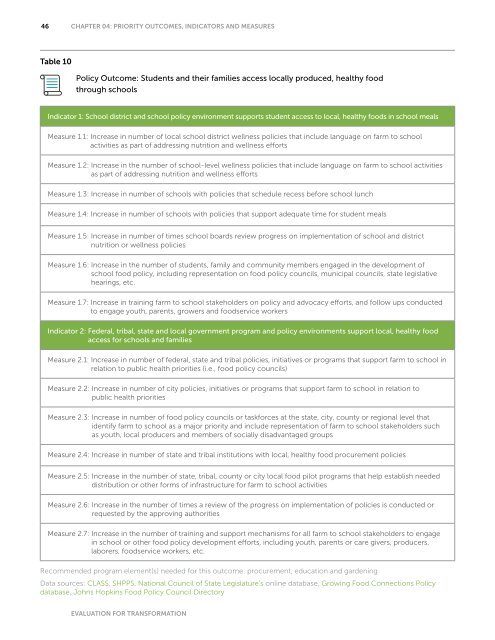Framework-08-25-14_web
Framework-08-25-14_web
Framework-08-25-14_web
Create successful ePaper yourself
Turn your PDF publications into a flip-book with our unique Google optimized e-Paper software.
46 CHAPTER 04: PRIORITY OUTCOMES, INDICATORS AND MEASURESTable 10Policy Outcome: Students and their families access locally produced, healthy foodthrough schoolsIndicator 1: School district and school policy environment supports student access to local, healthy foods in school mealsMeasure 1.1: Increase in number of local school district wellness policies that include language on farm to schoolactivities as part of addressing nutrition and wellness effortsMeasure 1.2: Increase in the number of school-level wellness policies that include language on farm to school activitiesas part of addressing nutrition and wellness effortsMeasure 1.3: Increase in number of schools with policies that schedule recess before school lunchMeasure 1.4: Increase in number of schools with policies that support adequate time for student mealsMeasure 1.5: Increase in number of times school boards review progress on implementation of school and districtnutrition or wellness policiesMeasure 1.6:Increase in the number of students, family and community members engaged in the development ofschool food policy, including representation on food policy councils, municipal councils, state legislativehearings, etc.Measure 1.7: Increase in training farm to school stakeholders on policy and advocacy efforts, and follow ups conductedto engage youth, parents, growers and foodservice workersIndicator 2: Federal, tribal, state and local government program and policy environments support local, healthy foodaccess for schools and familiesMeasure 2.1: Increase in number of federal, state and tribal policies, initiatives or programs that support farm to school inrelation to public health priorities (i.e., food policy councils)Measure 2.2: Increase in number of city policies, initiatives or programs that support farm to school in relation topublic health prioritiesMeasure 2.3: Increase in number of food policy councils or taskforces at the state, city, county or regional level thatidentify farm to school as a major priority and include representation of farm to school stakeholders suchas youth, local producers and members of socially disadvantaged groupsMeasure 2.4: Increase in number of state and tribal institutions with local, healthy food procurement policiesMeasure 2.5: Increase in the number of state, tribal, county or city local food pilot programs that help establish neededdistribution or other forms of infrastructure for farm to school activitiesMeasure 2.6: Increase in the number of times a review of the progress on implementation of policies is conducted orrequested by the approving authoritiesMeasure 2.7: Increase in the number of training and support mechanisms for all farm to school stakeholders to engagein school or other food policy development efforts, including youth, parents or care givers, producers,laborers, foodservice workers, etc.Recommended program element(s) needed for this outcome: procurement, education and gardeningData sources: CLASS, SHPPS, National Council of State Legislature’s online database, Growing Food Connections Policydatabase, Johns Hopkins Food Policy Council DirectoryEVALUATION FOR TRANSFORMATION


